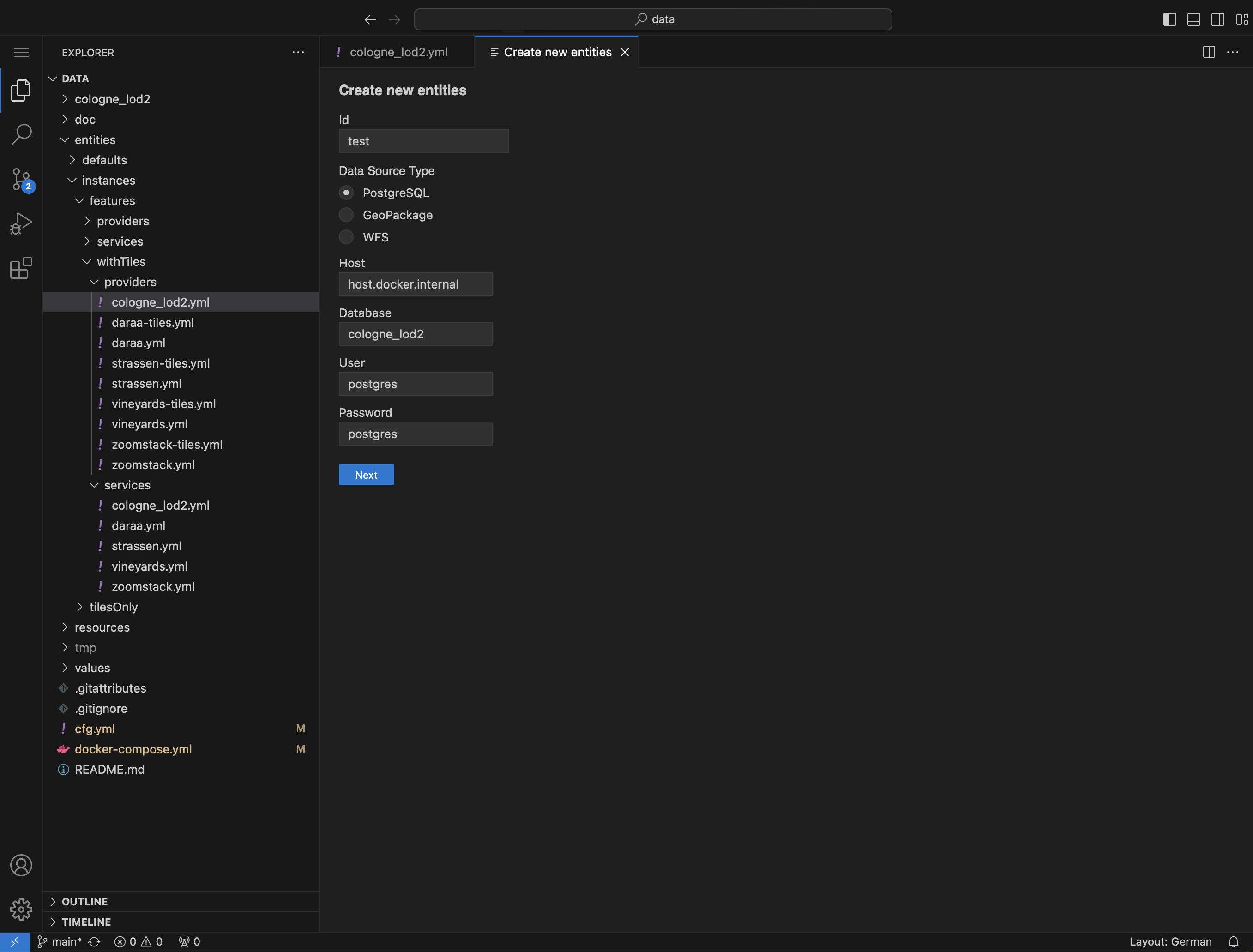ldproxy for VS Code
A VS Code extension that supports you in creating and updating ldproxy configurations.
Current state
- The current stable release is
v1.1.0. - It is available as a pre-release on the VS Code Marketplace (currently only for macOS and Linux).
- It can be used as a web application with the docker image that contains an open source version of VS Code for the Web.
Features
- Command
Create new entities: provides a graphical wizard to automatically generate provider and service configurations from data sources. - Command
Create new values: provides a graphical wizard to automatically generate value configurations, currently only MapLibre styles. - IntelliSense: autocompletion, shows available properties in YAML configuration files.
- Syntax checks: detects unknown or deprecated properties in YAML configuration files.
- Tooltips: shows documentation for properties in YAML configuration files.
Limitations
- The extension is not yet available for Windows, only MacOS and Linux are supported for now.
- The workspace root needs to be a ldproxy store directory for the extension to work properly. Parent directories that contain multiple store directories are not yet supported, and neither are multi-root workspaces.
- Tile Providers cannot be generated yet.
Outlook
v2.0.0general availability of the extension for VS Code Desktop (macOS, Windows, Linux), no known limitations
Installation
VS Code Desktop
Open the extensions view from the activity bar and search for ldproxy, then install the extension ldproxy for VS Code. This is a direct link to the extension on the VS Code Marketplace.
When installed, you may open a ldproxy store directory in VS Code, for example by using File -> Open Folder or by calling code in a terminal. You can then start editing your files.
Docker
The docker image is available at ghcr.io/ldproxy/editor. It expects the workspace to be mounted at /data. The application runs on port 80.
To start the editor with your ldproxy configuration directory in /path/to/ldproxy/cfg and access it at http://localhost:8080:
docker run -d -p 8080:80 -v /path/to/ldproxy/cfg:/data ghcr.io/ldproxy/editor
When you open the application at http://localhost:8080 in the browser, you will see the mounted ldproxy configuration directory on the left. You can now start to edit your files.
Note
Accessing the editor via http only works with localhost. If you want to setup an editor for remote access, you need a reverse proxy which provides https.
Usage
Unknown or deprecated properties will automatically be marked in open files. Hovering over a property will show the documentation.
For general help, check the documentation for VS Code.
IntelliSense (autocompletion)
To get a list of all available properties in a certain place in a YAML configuration file, you can press Ctrl+Space. (It is called Trigger suggest in the command palette, which also shows the configured hotkey.)
You can then use the cursor keys to navigate the suggestions and choose one with Enter. You might also start typing before or after triggering to narrow the suggestions.

Creating new entities
When you open the command palette and start typing ldproxy, the command ldproxy: Create new entities should appear at the top. Upon selecting, the graphical wizard will open in a new tab.
It allows you to automatically generate provider and service configurations from PostgreSQL/PostGIS, GeoPackage and WFS data sources.
Note
When trying to access a PostgreSQL database on the same host where the docker container is runnning, you have to use host.docker.internal instead of localhost.

Creating new values
When you open the command palette and start typing ldproxy, the command ldproxy: Create new values should appear near the top. Upon selecting, the graphical wizard will open in a new tab.
It currently only allows you to automatically generate a MapLibre style from a service configuration.
